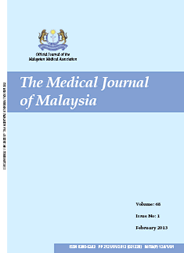MJM, Vol 70 Supplement 1 September 2015
Smoking among school-going adolescents in selected
secondary schools in Peninsular Malaysia - Findings from the Malaysia
Adolescents Health Risk Behaviour (MyAHRB)
Study
*Institute for Public Health, Kuala Lumpur, **Institute for Medical Research, Kuala Lumpur, ***Melaka Manipal Medical College, Melaka, ****Allied Health College, Sungai Buloh, Selangor
ABSTRACT
Introduction: A multitude of studies have revealed that smoking is a learned behaviour during adolescence and reducing the incidence of smoking has been identified as a long-term measure to curb the smoking menace in the Malaysian. The objective of this study was to assess the prevalence and the intra- and inter-personal factors associated with smoking among upper secondary school students in selected schools in Peninsular Malaysia.
Methods: Thirty secondary schools were randomly selected using two-stage proportionate to sampling and upper secondary school students from each selected school were invited to participate in the study. Prevalence and associated factors were assessed using a validated standardised questionnaire.
Results: This study revealed that the prevalence of smoking was 14.6%, significantly higher among males compared to females (27.9% vs 3.4%, p<0.001). The majority of smokers initiated smoking during the early adolescent years (60%) and almost half of the respondents bought the cigarettes themselves. Multivariable analysis revealed that the following factors increased the likelihood of being a current smoker: being male (adjusted odds ratio (aOR) 21.51; 95% CI 13.10-35.10); perceived poorer academic achievement (aOR 3.42, 95% CI 1.50-7.37), had one or both parents who smoked (aOR 1.80, 95% CI 1.32-2.45; aOR 6.50, 95% CI 1.65-25.65), and always feeling lonely (aOR 2.23, 95% CI 1.21-4.43). On the other hand, respondents with a higher religiosity (aOR 0.51, 95% CI 0.15-0.92) and protection (aOR 0.71, 95% CI 0.55-0.92) scores were less likely to smoke.
Conclusion: This study showed that the prevalence of smoking among adolescents is still high, despite implementation of several anti-smoking measures. More robust measures integrating the factors identified in this study are strongly recommended to curb the smoking menace among adolescents in Malaysia.
Keywords: Adolescence smoking, intrapersonal, interpersonal, school-going adolescents, Peninsular Malaysia
